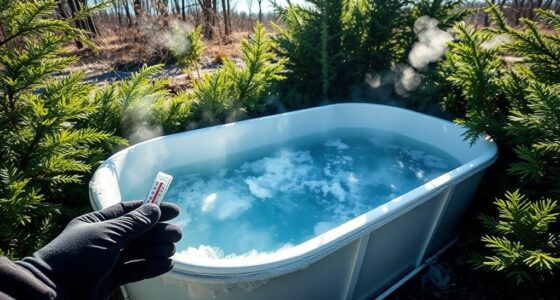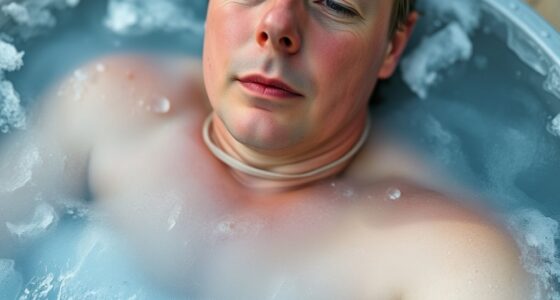To prepare for cold water immersion, start with mental strategies like practicing controlled breathing and visualizing calmness to prevent panic and build confidence. Gradually expose yourself to cold settings, such as cold showers, to help your body adapt securely. Focus on breath control to reduce shock and conserve energy during immersion. Staying patient and consistent enhances both your mental resilience and physical tolerance. Continue exploring ways to optimize your readiness and ensure safer cold water experiences.
Key Takeaways
- Practice controlled breathing techniques like diaphragmatic breathing or Wim Hof method to stay calm during immersion.
- Gradually expose yourself to cold water through cold showers to build tolerance safely.
- Focus on mental readiness by visualizing the experience and cultivating confidence beforehand.
- Maintain steady, deep breaths to prevent panic and reduce shock response during water entry.
- Incorporate patience and incremental exposure to adapt physically and mentally to cold immersion.

Preparing for cold water immersion requires both mental and physical readiness to guarantee safety and maximize benefits. One of the most critical aspects of mental preparation is mastering breath control. When you face cold water, your instinct might be to gasp or breathe rapidly, which can increase your panic and make it harder to stay calm. To avoid this, practice controlled breathing techniques beforehand. Deep, slow breaths help you stay centered and reduce the shock response when you first enter the water. Focus on inhaling deeply through your nose, filling your lungs gradually, then exhaling slowly through your mouth. This steady pattern not only calms your nervous system but also conserves energy, making it easier to handle the cold. Incorporate breath control exercises into your daily routine, such as diaphragmatic breathing or the Wim Hof method, to build resilience and confidence before your immersion. Additionally, understanding the importance of contrast therapy can motivate you to stick with gradual exposure, as it helps your body adapt more effectively to temperature changes.
Another essential component of mental readiness is embracing gradual exposure. Sudden immersion into freezing water can trigger intense reactions, but if you expose yourself slowly, your body can adapt more safely. Start by cold showers, gradually decreasing water temperature over time. This helps your body acclimate without overwhelming your system. As you become more comfortable, consider immersing yourself in cold water for short durations, then gradually increasing the time as your tolerance improves. This step-by-step approach allows your circulatory and nervous systems to adapt, reducing the likelihood of shock or hyperventilation. It also builds mental confidence, showing you that your body can handle the cold with proper preparation. Remember, patience is key; rushing into cold water without prior exposure can lead to panic and unsafe situations.
Frequently Asked Questions
How Long Should I Stay in Cold Water During My First Immersion?
For your first cold water immersion, stick to duration guidelines of about 1 to 3 minutes. This helps you experience benefits while prioritizing safety considerations. Keep an eye on how your body reacts, and don’t push beyond your comfort level. Start slowly, and gradually increase your time as you become more accustomed. Remember, listening to your body is key to safe and effective cold water exposure.
Can Cold Water Immersion Improve Athletic Performance?
Imagine opening hidden potential with cold water immersion, which can enhance your athletic recovery and promote cold water adaptation. By regularly immersing yourself, you may experience reduced muscle soreness, improved circulation, and increased resilience. These benefits can translate into better performance, faster recovery, and greater stamina. Embracing cold water helps your body adapt more efficiently, making it a valuable tool in your training routine for sustained athletic excellence.
What Are the Risks of Cold Water Exposure for Beginners?
As a beginner, cold water exposure can pose hypothermia risks if you stay in too long or the water is very cold. You should also be aware of cardiovascular concerns, especially if you have pre-existing heart issues, as cold water can cause sudden heart rate increases. Always start slowly, listen to your body, and never immerse alone to minimize these risks and guarantee safety.
How Do I Recover After Cold Water Immersion?
After cold water immersion, you should focus on gentle post immersion stretching to ease muscle tension and promote circulation. Engage in mental recovery techniques like deep breathing or mindfulness to calm your mind and reduce stress. Rewarm gradually with warm clothing or a blanket, and hydrate to replenish fluids. These steps help your body recover efficiently, minimize soreness, and restore your mental clarity, ensuring you feel balanced and refreshed afterward.
Are There Specific Breathing Techniques to Manage Cold Shock?
Yes, specific breathing techniques can help manage cold shock. Practice controlled, deep breaths to maintain calm and regulate your heart rate. Techniques like diaphragmatic breathing or box breathing can slow your breathing and reduce panic. When you hit cold water, focus on steady, deliberate breaths to keep your body relaxed. These methods improve cold shock management by preventing hyperventilation and helping you stay composed during immersion.
Conclusion
Getting ready for cold water immersion is both a mental and physical challenge. Remember, studies show that regular cold exposure can boost your immune system and improve mood. So, stay consistent and focus on your breathing to stay calm. With proper preparation, you’ll build resilience and enjoy the benefits safely. Embrace the cold—your body and mind will thank you for it!









